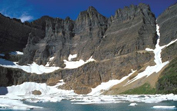Glacier National Park loses two more glaciers
 Glacier National Park has lost two more of its glaciers to climate change and many of the rest may be gone by the end of the decade, a government researcher said Wednesday.
Glacier National Park has lost two more of its glaciers to climate change and many of the rest may be gone by the end of the decade, a government researcher said Wednesday.Warmer temperatures have reduced the number of named glaciers in the northwestern Montana park to 25, said Dan Fagre said, an ecologist with the US Geological Survey.
“When we’re measuring glacier margins, by the time we go home the glacier is already smaller than what we’ve measured,” Fagre said.
From the Himalayas to Alaska, glacier melting has accelerated in recent decades as global temperatures increased. The meltoff shows the climate is changing, but does not show exactly what is causing temperatures to go up, Fagre said.
The park’s glaciers have been slowly melting since about 1850, when the centuries-long Little Ice Age ended. They once numbered as many as 150, and 37 of those glaciers eventually were named.
A glacier needs to be 25 acres to qualify for the title.
If it shrinks any smaller, it does not always stop moving right away. A smaller mass of ice on a steep slope would still continue to grind its way through the mountains, but eventually disappears completely.
The latest two to fall below the 25 acre (10 hectare) threshold were Miche Wabun and Shepard. Each had shrunk by roughly 55 percent since the mid-1960s. The largest remaining glacier in the park is Harrison Glacier, at about 465 acres (190 hectares).
Smaller glaciers and warmer temperatures could lower stream flows, which in turn prompt fishing restrictions and hobble whitewater rafting businesses, said Denny Gignoux, who runs an outfitting business in West Glacier. Tourism is a $1 billion a year industry in the area.
You can return to the main Market News page, or press the Back button on your browser.

